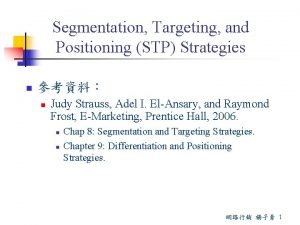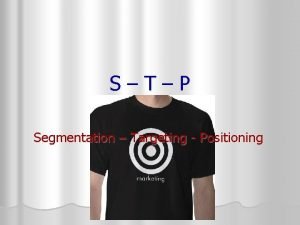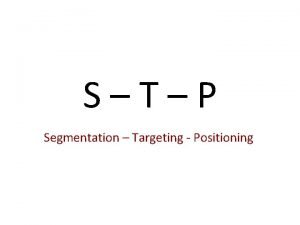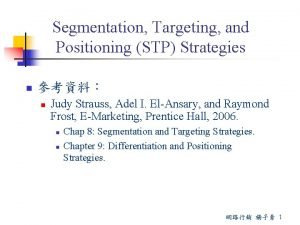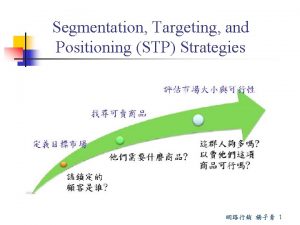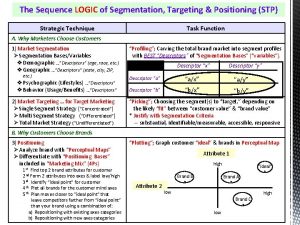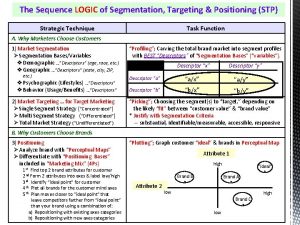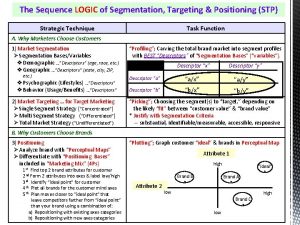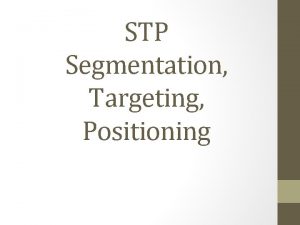Session 5 Segmentation Targeting Positioning STP Chapter 8















- Slides: 15

Session 5 Segmentation, Targeting, Positioning (STP) Chapter 8 & 10

Segmentation , Targeting and Positioning (STP) • segmentation – Identify and profile distinct groups of buyers with similar needs • targeting – Select one or more market segments to enter • positioning – For each target segment, establish and communicate the key distinctive benefit(s) of the company’s market offering. 2

A few more words on STP • STP is the proxy for individualized solution • You should always think about STP, but sometimes it’s not sensible Type 2 sweet Type 3 sour Type 1 sweet 3

STP Process Segmentation Segment evaluation and targeting Segment positioning Marketing mix formulation 4

Segmentation Market segmentation: The process of identifying and profiling distinct groups of buyers with similar needs Segment: A relatively homogeneous group of customers who will respond similarly to a marketing mix. Good segmentation= Customers must be as similar as possible within a segment, and as different as possible between segments

Segmentation Approaches • Geographic segmentation divides the market into different geographical units such as nations, regions, states, counties, or cities (also rural-suburbs, climate, etc) • Demographic segmentation divides the market into groups based on variables such as age, gender, family size, family life cycle, income, occupation, education, religion, race, generation, and nationality – Age and Life-cycle stage segmentation – Gender segmentation – Income segmentation

Segmentation Approaches (cont. ) • Psychographic segmentation divides buyers into different groups based on social class, lifestyle, or personality traits • Behavioral segmentation divides buyers into groups based on their knowledge, attitudes, uses, or responses to a product – – Occasions Benefits sought User status and Usage rate Loyalty status

Targeting – Select Target Segments • Which and how many customer segments to serve? • How many marketing mix offerings do we use to go after them?

SWOT Analysis Good for firm Bad for firm Internal Strengths • Internal to the organization • Characteristics of the business or team that give it an advantage over others in the industry • E. g. good location Weaknesses • Internal to the organization • Characteristics that place the firm at a disadvantage relative to others • E. g. weak cash flow External Opportunities • External environment • External chances to make greater sales or profits in the environment • E. g. large market size Threats • External environment • External elements in the environment that could cause trouble for the business • E. g. high tariff (controllable) Uncontrollable 9

3 factors to consider when evaluating attractiveness of customer segments • Segment size and growth • Segment structural attractiveness – Any strong competitors – Relative power of customers – Relative power of suppliers • Company long-run objectives and resources – Do we want to be known for serving this customer segment? – Do we have the skill set to deliver superior value to this segment?

Positioning • Positioning: – The act of designing the company’s offering and image to occupy a distinctive place in the mind of the target market – Crystallized as a value proposition (why target market should buy the product) • A positioning statement (Kotler and Keller): – To (target group and need) our (Brand) is (concept) that (point-ofdifference). 11

Ideal Positioning Relevance Believability Distinctiveness 12

Positioning Pitfalls • • Convey too many benefits: – Unique selling proposition (one central benefit) is usually sufficient – Sometimes 2 -3 benefit positioning. Four major positioning errors – Underpositioning – Overpositioning – Confused positioning – Doubtful positioning 13

Key Points Segmentation, Targeting and Positioning (STP) is the most important marketing concept you should remember! Good STP requires rigorous qualitative and quantitative research! At least you have asked the right question! 14

Managerial Challenge How to position our product • If position high, we need to invest more on R&D and market development, cost will be higher. We are afraid that we won’t be able to get a lot of customers at the high end. • If position low, we will have high revenue but little profit. We are also worried about images of future brands. 15
 Stp example
Stp example Chapter 7 segmentation targeting and positioning
Chapter 7 segmentation targeting and positioning Market segmentation and targeting ppt
Market segmentation and targeting ppt Nivea segmentation targeting and positioning
Nivea segmentation targeting and positioning Sony market segmentation, targeting and positioning
Sony market segmentation, targeting and positioning Positioning involves meeting consumers lower performance
Positioning involves meeting consumers lower performance Sony market segmentation, targeting and positioning
Sony market segmentation, targeting and positioning Nokia market segmentation targeting and positioning
Nokia market segmentation targeting and positioning Nivea market segmentation
Nivea market segmentation Segmentation targeting and positioning of nestle
Segmentation targeting and positioning of nestle Segmentation targeting and positioning
Segmentation targeting and positioning Positioning segmentation targeting
Positioning segmentation targeting Market segmentation, targeting and positioning
Market segmentation, targeting and positioning Bssu
Bssu Psychographic segmentation
Psychographic segmentation Positioning methods
Positioning methods
